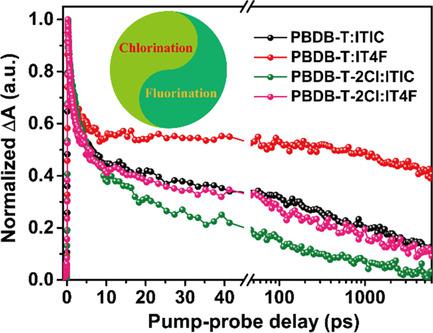Our official English website, www.x-mol.net, welcomes your
feedback! (Note: you will need to create a separate account there.)
Multiple Temporal‐Scale Photocarrier Dynamics Induced by Synergistic Effects of Fluorination and Chlorination in Highly Efficient Nonfullerene Organic Solar Cells
Solar RRL ( IF 6.0 ) Pub Date : 2020-01-30 , DOI: 10.1002/solr.201900552 Kang-Ning Zhang 1 , Meng-Si Niu 1 , Zhi-Nan Jiang 2 , Zhi-Hao Chen 1 , Tong Wang 1 , Meng-Meng Wei 1 , Chao-Chao Qin 2 , Lin Feng 1 , Wei Qin 1 , Shu-Kong So 3 , Xiao-Tao Hao 1, 4
Solar RRL ( IF 6.0 ) Pub Date : 2020-01-30 , DOI: 10.1002/solr.201900552 Kang-Ning Zhang 1 , Meng-Si Niu 1 , Zhi-Nan Jiang 2 , Zhi-Hao Chen 1 , Tong Wang 1 , Meng-Meng Wei 1 , Chao-Chao Qin 2 , Lin Feng 1 , Wei Qin 1 , Shu-Kong So 3 , Xiao-Tao Hao 1, 4
Affiliation

|
Fluorination and chlorination have yielded a novel class of materials and achieved tremendous progress in enhancing photovoltaic efficiency in organic solar cells (OSCs). However, their effects on photocarrier dynamics remain elusive in these organic photovoltaic systems. Herein, a comprehensive study on the underlying mechanisms is conducted based on a 2 × 2 photovoltaic matrix, consisting of PBDB‐T, PBDB‐T‐2Cl, ITIC, and IT4F. Chlorination of donors enhances exciton migration and relaxation rates and promotes the extraction of polarons. The more efficient charge transfer and a larger proportion of long‐lived polarons are observed in fluorine‐containing acceptor‐based systems, which are in favor of charge generation in the actual devices. According to the enlarged dielectric constant in the PBDB‐T‐2Cl:IT4F blend, the improved exciton delocalization, the decreased exciton binding energy, and Coulomb capture radius are obtained relative to other three binary systems, which can increase charge separation efficiency and reduce the probability of bimolecular recombination. The simultaneous fluorination and chlorination can optimize molecular packing and nanoscale phase separation, facilitating effective exciton diffusion, exciton dissociation, and charge transport. These results highlight the important role of fluorination and chlorination on these fundamental mechanisms, possibly resulting in some new molecular design principles toward high‐performance OSCs.
中文翻译:

高效非富勒烯有机太阳能电池中氟化和氯化协同效应引起的多个时标光子动力学。
氟化和氯化产生了新型材料,并在提高有机太阳能电池(OSC)的光伏效率方面取得了巨大进步。然而,在这些有机光伏系统中,它们对光载流子动力学的影响仍然难以捉摸。在这里,基于PBDB-T,PBDB-T-2Cl,ITIC和IT4F组成的2×2光伏矩阵对潜在机理进行了全面研究。供体的氯化可增加激子迁移和弛豫速率,并促进极化子的提取。在含氟受体体系中观察到更有效的电荷转移和更长寿命的极化子,这有利于实际装置中的电荷产生。根据PBDB‐T‐2Cl:IT4F共混物中增大的介电常数,相对于其他三个二元体系,获得了改善的激子离域,降低的激子结合能和库仑俘获半径,这可以提高电荷分离效率并降低双分子重组的可能性。同时氟化和氯化可优化分子堆积和纳米级相分离,促进有效的激子扩散,激子离解和电荷传输。这些结果突出了氟化和氯化在这些基本机理上的重要作用,可能导致针对高性能OSC的一些新的分子设计原理。这可以提高电荷分离效率并降低双分子重组的可能性。同时氟化和氯化可优化分子堆积和纳米级相分离,促进有效的激子扩散,激子离解和电荷传输。这些结果突出了氟化和氯化在这些基本机理上的重要作用,可能导致针对高性能OSC的一些新的分子设计原理。这可以提高电荷分离效率并降低双分子重组的可能性。同时氟化和氯化可优化分子堆积和纳米级相分离,促进有效的激子扩散,激子离解和电荷传输。这些结果突出了氟化和氯化在这些基本机理上的重要作用,可能导致针对高性能OSC的一些新的分子设计原理。
更新日期:2020-01-30
中文翻译:

高效非富勒烯有机太阳能电池中氟化和氯化协同效应引起的多个时标光子动力学。
氟化和氯化产生了新型材料,并在提高有机太阳能电池(OSC)的光伏效率方面取得了巨大进步。然而,在这些有机光伏系统中,它们对光载流子动力学的影响仍然难以捉摸。在这里,基于PBDB-T,PBDB-T-2Cl,ITIC和IT4F组成的2×2光伏矩阵对潜在机理进行了全面研究。供体的氯化可增加激子迁移和弛豫速率,并促进极化子的提取。在含氟受体体系中观察到更有效的电荷转移和更长寿命的极化子,这有利于实际装置中的电荷产生。根据PBDB‐T‐2Cl:IT4F共混物中增大的介电常数,相对于其他三个二元体系,获得了改善的激子离域,降低的激子结合能和库仑俘获半径,这可以提高电荷分离效率并降低双分子重组的可能性。同时氟化和氯化可优化分子堆积和纳米级相分离,促进有效的激子扩散,激子离解和电荷传输。这些结果突出了氟化和氯化在这些基本机理上的重要作用,可能导致针对高性能OSC的一些新的分子设计原理。这可以提高电荷分离效率并降低双分子重组的可能性。同时氟化和氯化可优化分子堆积和纳米级相分离,促进有效的激子扩散,激子离解和电荷传输。这些结果突出了氟化和氯化在这些基本机理上的重要作用,可能导致针对高性能OSC的一些新的分子设计原理。这可以提高电荷分离效率并降低双分子重组的可能性。同时氟化和氯化可优化分子堆积和纳米级相分离,促进有效的激子扩散,激子离解和电荷传输。这些结果突出了氟化和氯化在这些基本机理上的重要作用,可能导致针对高性能OSC的一些新的分子设计原理。











































 京公网安备 11010802027423号
京公网安备 11010802027423号